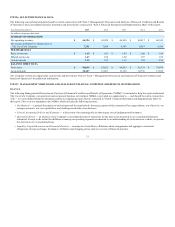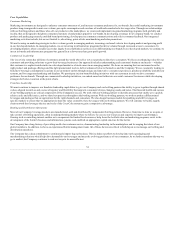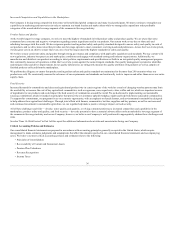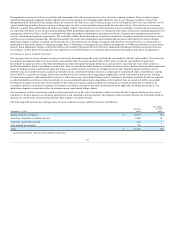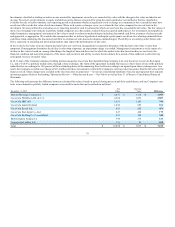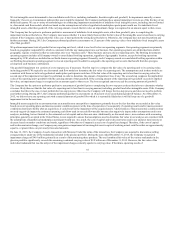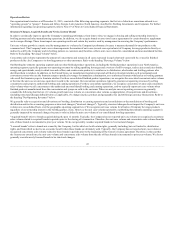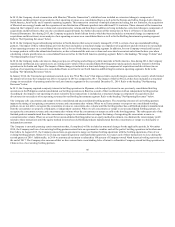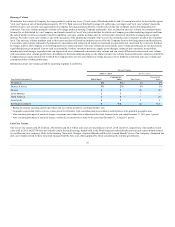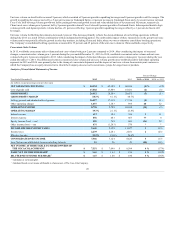Coca Cola 2015 Annual Report Download - page 43
Download and view the complete annual report
Please find page 43 of the 2015 Coca Cola annual report below. You can navigate through the pages in the report by either clicking on the pages listed below, or by using the keyword search tool below to find specific information within the annual report.
We test intangible assets determined to have indefinite useful lives, including trademarks, franchise rights and goodwill, for impairment annually, or more
frequently if events or circumstances indicate that assets might be impaired. Our Company performs these annual impairment reviews as of the first day of our
third fiscal quarter. We use a variety of methodologies in conducting impairment assessments of indefinite-lived intangible assets, including, but not limited
to, discounted cash flow models, which are based on the assumptions we believe hypothetical marketplace participants would use. For indefinite-lived
intangible assets, other than goodwill, if the carrying amount exceeds the fair value, an impairment charge is recognized in an amount equal to that excess.
The Company has the option to perform a qualitative assessment of indefinite-lived intangible assets, other than goodwill, prior to completing the
impairment test described above. The Company must assess whether it is more likely than not that the fair value of the intangible asset is less than its carrying
amount. If the Company concludes that this is the case, it must perform the testing described above. Otherwise, the Company does not need to perform any
further assessment. During 2015, the Company performed qualitative assessments on 25 percent of the carrying value of our indefinite-lived intangible assets
other than goodwill.
We perform impairment tests of goodwill at our reporting unit level, which is one level below our operating segments. Our operating segments are primarily
based on geographic responsibility, which is consistent with the way management runs our business. Our operating segments are subdivided into smaller
geographic regions or territories that we sometimes refer to as "business units." These business units are also our reporting units. The Bottling Investments
operating segment includes all Company-owned or consolidated bottling operations, regardless of geographic location, except for bottling operations
managed by CCR, which are included in our North America operating segment. Generally, each Company-owned or consolidated bottling operation within
our Bottling Investments operating segment is its own reporting unit. Goodwill is assigned to the reporting unit or units that benefit from the synergies
arising from each business combination.
The goodwill impairment test consists of a two-step process, if necessary. The first step is to compare the fair value of a reporting unit to its carrying value,
including goodwill. We typically use discounted cash flow models to determine the fair value of a reporting unit. The assumptions used in these models are
consistent with those we believe hypothetical marketplace participants would use. If the fair value of the reporting unit is less than its carrying value, the
second step of the impairment test must be performed in order to determine the amount of impairment loss, if any. The second step compares the implied fair
value of the reporting unit's goodwill with the carrying amount of that goodwill. If the carrying amount of the reporting unit's goodwill exceeds its implied
fair value, an impairment charge is recognized in an amount equal to that excess. The loss recognized cannot exceed the carrying amount of goodwill.
The Company has the option to perform a qualitative assessment of goodwill prior to completing the two-step process described above to determine whether
it is more likely than not that the fair value of a reporting unit is less than its carrying amount, including goodwill and other intangible assets. If the Company
concludes that this is the case, it must perform the two-step process. Otherwise, the Company will forego the two-step process and does not need to perform
any further testing. During 2015, the Company performed qualitative assessments on 10 percent of our consolidated goodwill balance. As of December 31,
2015, we did not have any reporting unit with a material amount of goodwill for which it is reasonably likely that it will fail step one of a goodwill
impairment test in the near term.
Intangible assets acquired in recent transactions are naturally more susceptible to impairment, primarily due to the fact that they are recorded at fair value
based on recent operating plans and macroeconomic conditions present at the time of acquisition. Consequently, if operating results and/or macroeconomic
conditions deteriorate shortly after an acquisition, it could result in the impairment of the acquired assets. A deterioration of macroeconomic conditions may
not only negatively impact the estimated operating cash flows used in our cash flow models but may also negatively impact other assumptions used in our
analyses, including, but not limited to, the estimated cost of capital and/or discount rates. Additionally, as discussed above, in accordance with accounting
principles generally accepted in the United States, we are required to ensure that assumptions used to determine fair value in our analyses are consistent with
the assumptions a hypothetical marketplace participant would use. As a result, the cost of capital and/or discount rates used in our analyses may increase or
decrease based on market conditions and trends, regardless of whether our Company's actual cost of capital has changed. Therefore, if the cost of capital
and/or discount rates change, our Company may recognize an impairment of an intangible asset in spite of realizing actual cash flows that are approximately
equal to, or greater than, our previously forecasted amounts.
On June 12, 2015, the Company closed a transaction with Monster. Under the terms of the transaction, the Company was required to discontinue selling
energy products under one of the trademarks included in the glacéau portfolio. During the year ended December 31, 2015, the Company recognized
impairment charges of $418 million, primarily as a result of discontinuing these products. The total combined fair value of the various trademarks in the
glacéau portfolio significantly exceeds the remaining combined carrying value of $2.9 billion as of December 31, 2015. However, the fair value of the
individual trademark that was the subject of the impairment charges currently equals its carrying value. If the future operating results of
41


